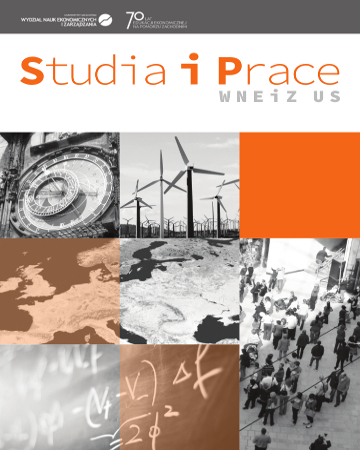
ISSN: 2450-7733
eISSN: 2300-4096
OAI
DOI: 10.18276/sip.2018.52/2-37


Liste der Ausgaben /
nr 52/2 2018
Wykorzystanie technologii chmury obliczeniowej w przedsiębiorstwach w krajach Unii Europejskiej
| Autoren: |
Krystyna
Poznańska
Szkoła Główna Handlowa w Warszawie Artur Marczak Szkoła Główna Handlowa w Warszawie |
| Schlüsselbegriffe: | technologie informatyczne chmura obliczeniowa specyfika i korzyści modele chmury obliczeniowej |
| Veröffentlichungsdatum der gesamten Ausgabe: | 2018 |
| Seitenanzahl: | 13 (481-493) |
| Klasyfikacja JEL: | M15 O33 |
Abstract
Rewolucja technologiczna, która ma miejsce obecnie, wymusza na przedsiębiorcach prowadzenie działalności w sposób innowacyjny, nowoczesny, z wykorzystaniem nowoczesnych technologii informatycznych. Przykładem takiej technologii jest chmura obliczeniowa, której wykorzystanie w gospodarce światowej systematycznie wzrasta. Powstaje więc pytanie o wykorzystanie tej technologii w Polsce na tle krajów Unii Europejskiej oraz o to, jakie korzyści dla przedsiębiorców wynikają z jej użytkowania. Biorąc to pod uwagę, jako podstawowy cel opracowania przyjęto zdefiniowanie chmury obliczeniowej i jej modeli oraz opisanie możliwości jej wykorzystania w różnych obszarach aktywności przedsiębiorstw w krajach Unii Europejskiej i w Polsce. Rozważania oparte zostały na przeglądzie literatury krajowej i zagranicznej oraz dostępnych danych Eurostatu. Z przeprowadzonej analizy wynika, iż wykorzystanie przez przedsiębiorstwa technologii chmury obliczeniowej w krajach Unii Europejskiej w ostatnim okresie znacznie wzrosło. W 2016 roku średnia wykorzystania chmury obliczeniowej w krajach Unii wynosi 22%. Jest to wzrost o 3% w stosunku do 2014 roku. Przedsiębiorcy wykorzystujący chmurę obliczeniową wskazują ponadto wiele korzyści związanych ze wzrostem wydajności pracowników, ich zadowoleniem, a także z poprawą przewagi konkurencyjnej, wzrostem sprzedaży oraz spadkiem kosztów związanych z wykorzystaniem infrastruktury IT. Podkreśla się również, że chmura obliczeniowa i usługi w niej oferowane będą odgrywały znaczącą rolę w rozwoju przedsiębiorstw z sektora MSP, przynosząc im konkretne korzyści, których odzwierciedleniem jest między innymi poprawa wyników finansowych.
herunterladen
Artikeldatei
Bibliographie
| 1. | Communication from the Commission to the European parliament, the council, the Europe an economic and social committee and the committee of the regions. Unleashing the Potential of Cloud Computing in Europe (2012). Brussels. |
| 2. | European Commission. The Future of Cloud Computing – Opportunities for European Cloud Computing beyond 2010. Pobrane z: http://cordis.europa.eu/fp7/ ict/ssai/docs/cloud-report-final.pdf (11.02.2014). |
| 3. | Eurostat. Cloud Computing Use in EU Enterprises. Pobrane z: http://ec.europa.eu/ eurostat/en/web/products-eurostat-news/-/DDN-20170330-1 (11.05.2017). |
| 4. | Huang, B., Li, C., Yin, C., Zhao, X. (2013). Cloud Manufacturing Service Platform for Small- and Medium-sized Enterprises. International Journal of Advanced Manufacturing Technology, 65 (9), 1261–1272. |
| 5. | Hurwitz, J., Kaufman, M. (2012). Cloud for Dummies. New York: IBM Midsize Company Limited Edition. |
| 6. | IBM Polska (2012). Początek rewolucji w przetwarzaniu informacji. Pobrane z: http://www.ican.pl/files/PDF/raport_991.pdf (1.03.2014). |
| 7. | KPMG International (2014). Cloud Survey Report: Elevating Business in the Cloud. Pobrane z: https://assets.kpmg.com/content/dam/kpmg/pdf/2014/12/2014-kpmg-cloud-survey |
| 8. | -report.pdf (5.05.2017). |
| 9. | KPMG International. The Cloud Takes Shape. Pobrane z: http://mcr.doingbusiness.ro/uploads/516e6428ae72 ethe-cloud-takes-shapev3.pdf (10.05.2017). |
| 10. | Łapiński, K., Wyżnikiewicz, B. (2011a). Cloud Computing – elastyczność, efektywność, bezpieczeństwo. Warszawa: IBnGR. |
| 11. | Łapiński, K., Wyżnikiewicz, B. (2011b). Cloud Computing. Wpływ na konkurencyjność przedsiębiorstw i gospodarkę Polski. Gdańsk: IBnGR. |
| 12. | Małyszko, M. (2009). SAAS jako metoda świadczenia e-usług. Warszawa: PARP. Pobrane z: http://www.web.gov.pl/g2/big/2009_03/c6dfab4e6f795ca260afdc0c04f5f5c7.pdf (1.03. 2014). |
| 13. | Marczak, A. (2014). Ekonomiczne aspekty wykorzystania chmury obliczeniowej w małych i średnich przedsiębiorstwach. Zarządzanie. Teoria i Praktyka, 9 (1), 67–75. |
| 14. | Meena, S. (2012). Building a Secure Enterprise Model for Cloud Computing Environment. Academy of Information and Management Sciences Journal, 15 (1), 127–133. |
| 15. | Mell, P., Grance, Y. (2011). The NIST Definition of Cloud Computing. National Institute of Standards and Technology Special Publication 800-145. |
| 16. | Serafinowicz, A. (2011). Cloud computing, czyli chmury obliczeniowe. Nie błądzić w chmurach.Pobrane z: http://pclab.pl/art44389-8.html (12.04.2014). |
| 17. | Sommer, T., Nobile, T. (2012). The Conundrum of Security in Modern Cloud Computing. Communications of the IIMA, 12 (4), 15–40. |
| 18. | Teixeira, C., Pinto, J.S., Azevedo, R., Batista, T., Monteiro, A. (2014). The Building Blocks of a PaaS. Journal of Network and Systems Management, 22, 75–99. |